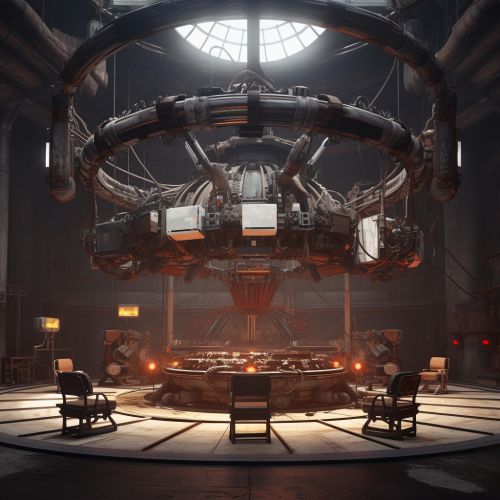Tokamak
Introduction
A Tokamak is a device used in fusion power research to confine a plasma within a magnetic field, with the aim of sustaining a controlled nuclear fusion reaction. The name "tokamak" comes from the Russian words "тороидальная камера в магнитных катушках" (toroidal'naya kamera v magnitnykh katushkakh), which translates to "toroidal chamber with magnetic coils". The tokamak is one of several types of confinement devices being developed to produce controlled thermonuclear fusion power.


Design and Operation
The tokamak is essentially a torus, or doughnut-shaped, device that uses a powerful magnetic field to confine a plasma. The plasma is heated to extremely high temperatures, with the goal of achieving conditions under which nuclear fusion can occur. The magnetic field is used to keep the plasma away from the machine's walls, which would rapidly cool the plasma and disrupt the fusion reactions.
The tokamak's magnetic field is produced by a combination of external coils and an electrical current driven through the plasma. The external coils generate a toroidal field, while the current through the plasma produces a poloidal field. Together, these create a helical field that confines the plasma in the shape of a twisted ring.
History
The concept of the tokamak was first proposed in the 1950s by Soviet physicists Igor Tamm and Andrei Sakharov, based on the earlier work of Oleg Lavrentiev. The first tokamak, T-1, was built and operated in 1958 at the Kurchatov Institute in Moscow. Early tokamaks were plagued by instabilities and difficulties in maintaining a stable plasma, but these issues were largely resolved with the introduction of the "high field" tokamak concept in the late 1960s.
Current Research and Future Developments
Today, tokamaks are at the forefront of fusion research. The largest and most advanced tokamak in the world is the ITER project in France, a multinational collaboration aiming to demonstrate the feasibility of fusion power on a commercial scale. Other significant tokamak projects include the Joint European Torus (JET) in the UK, the Tokamak Energy project, and the EAST project in China.
Research in tokamaks today focuses on improving the efficiency of plasma confinement, increasing the duration of fusion reactions, and developing methods for handling the high heat and particle fluxes that occur in a fusion reactor. Future developments may include the use of advanced materials for the tokamak walls, and the development of new techniques for plasma heating and current drive.
Challenges
Despite the progress made in tokamak research, there are still significant challenges to be overcome. These include the difficulty of maintaining a stable plasma for long periods, the high energy input required to heat the plasma to fusion temperatures, and the handling of the intense heat flux from the plasma to the tokamak walls. In addition, the neutron radiation produced by the fusion reactions can cause damage to the tokamak structure and materials, and poses a significant engineering challenge.
